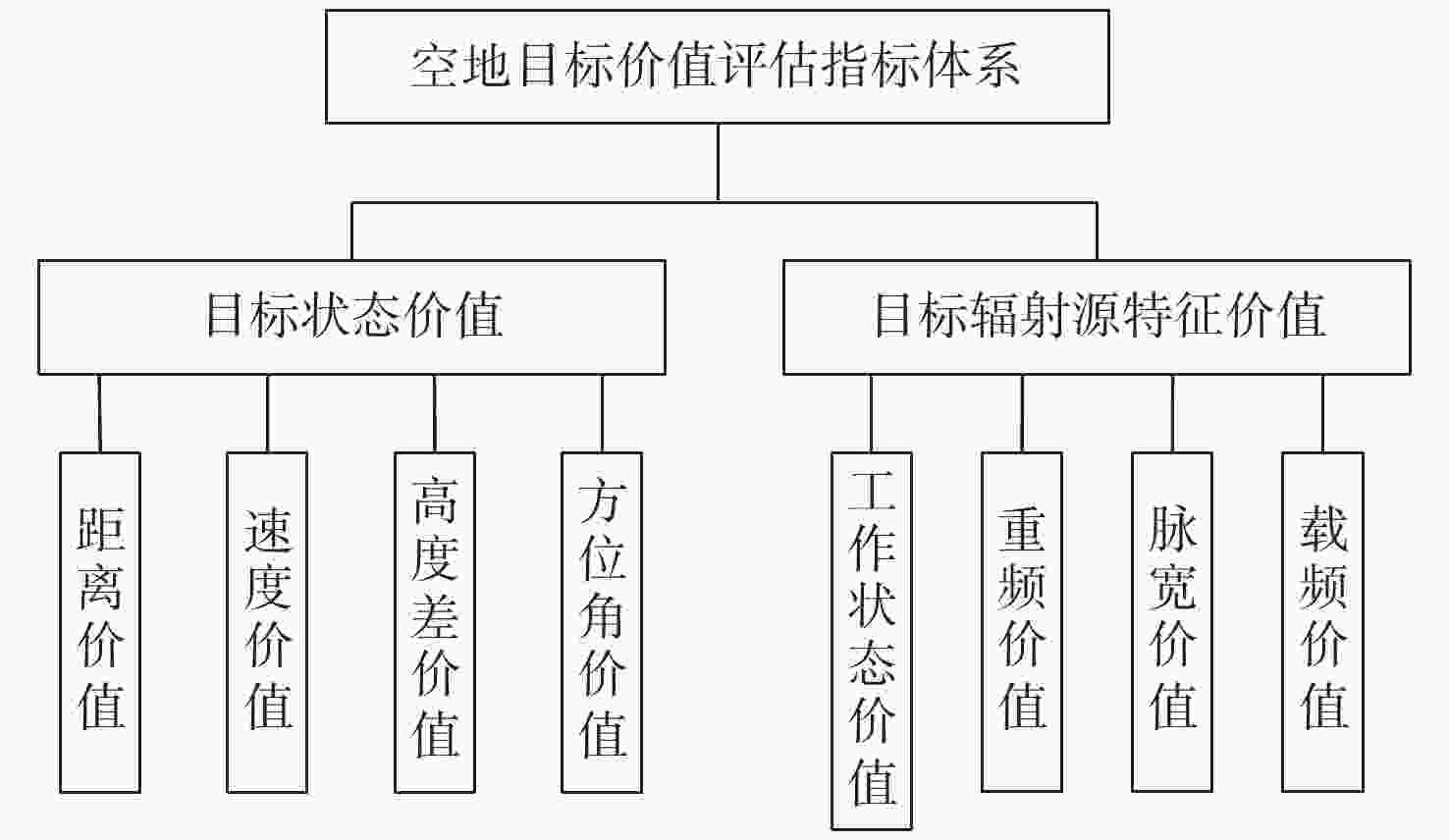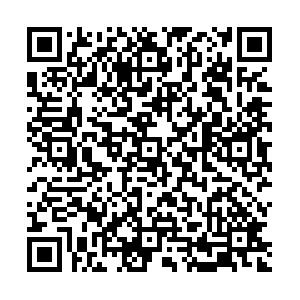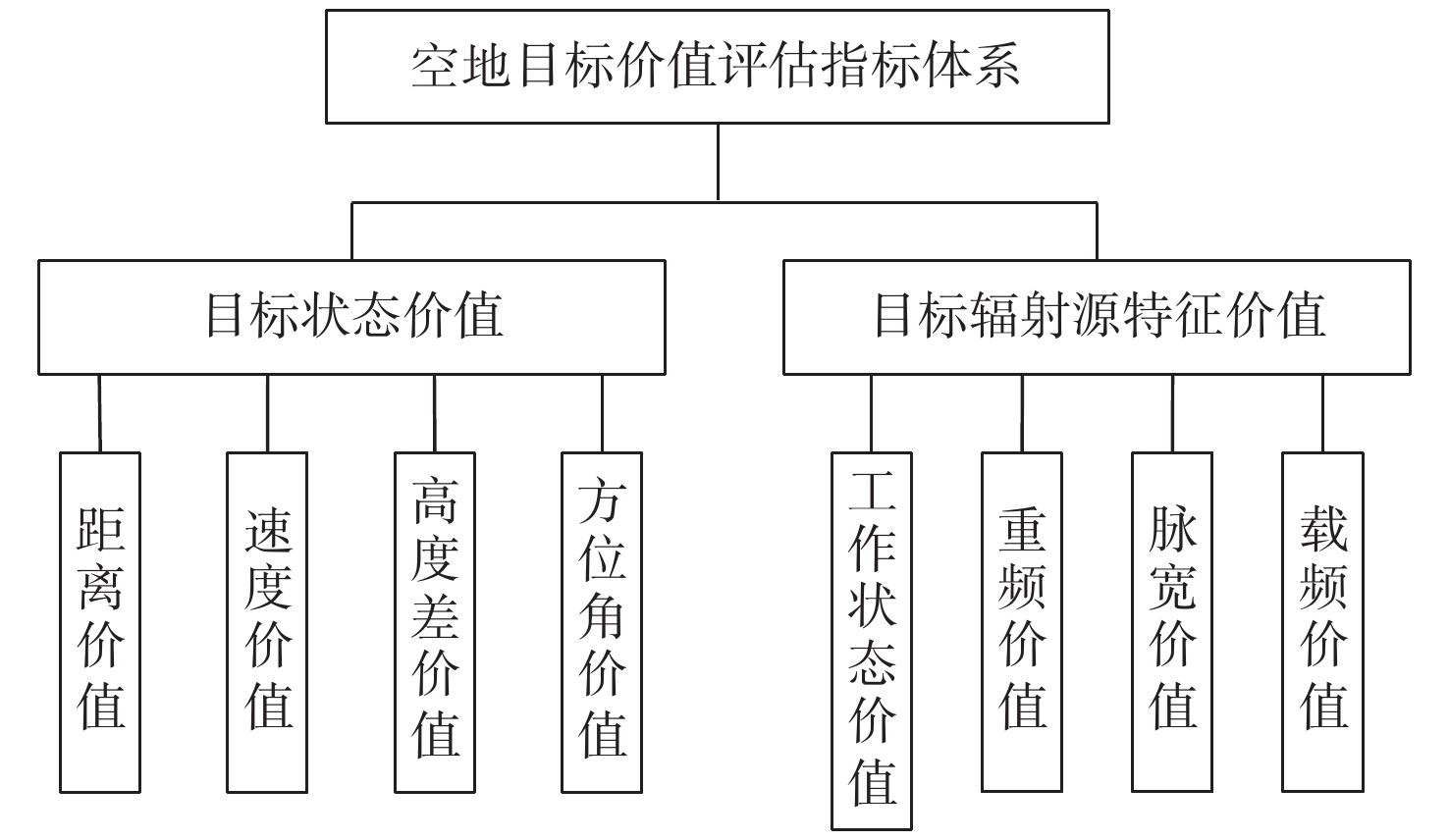A comprehensive air-ground target attackability value ranking based on comprehensive weighting
-
摘要:
智能化时代的战争中,无人作战能力愈发成为评判大国军事实力的重要指标,无人机在完成自主攻击任务时,需要对当前战场环境下敌对方空地军事目标的打击价值进行评估排序。根据战场态势下敌方空中目标及地面目标对己方的威胁程度,确定目标的打击价值,建立空地目标价值综合评估的指标体系,采用熵权法和层次分析法相结合的主客观综合赋权法对指标进行赋权,最后通过扇形雷达图法对空地目标价值综合评估排序,并通过实例仿真计算多个空中和地面目标的价值,得出了符合常规的目标价值排序。
Abstract:In the area of intelligent warfare, unmanned system combat capabilities have increasingly become an important factor in the military strength of major powers. When utilizing unmanned aerial vehicles for air-to-ground assault operations, it is imperative to assess and prioritize the enemy’s ground targets' strike values. This paper presents a newly developed index scheme to determine the threat values of both air and ground targets in a real-time fashion. In the proposed method, the weights of each threat factor were calculated through a combined method, using the entropy weight method and the analytic hierarchy process. Subsequently, the ranking of both air and ground targets is determined and visualized through a sectoral radar map. A number of ground and aerial targets are valued using a simulation example, and the result is a target value ranking that complies with the convention.
-
表 1 指标判断矩阵
Table 1. Indicator judgment matrix
指标 距离 速度 方位角 高度差 工作状态 重频 脉宽 载频 距离 1 1 5/3 5/3 5/7 5/1 5/1 5/1 速度 1 1 5/3 5/3 5/7 5/1 5/1 5/1 方位角 3/5 3/5 1 1 3/7 3/1 3/1 3/1 高度差 3/5 3/5 1 1 3/7 3/1 3/1 3/1 工作状态 7/5 7/5 7/3 7/3 1 7/1 7/1 7/1 重频 1/5 1/5 1/3 1/3 1/7 1 1 1 脉宽 1/5 1/5 1/3 1/3 1/7 1 1 1 载频 1/5 1/5 1/3 1/3 1/7 1 1 1 注:表内数据表示各指标间的相对重要程度,如第1行第2列的1表示速度的重要程度和距离的重要程度比值为1,即同等重要。 表 2 随机一致性指标
Table 2. Random coherence indicator
矩阵阶数 $S_{\mathrm{R.I.}}$ 矩阵阶数 $S_{\mathrm{R.I.}}$ 1 0 5 1.12 2 0 6 1.26 3 0.52 7 1.36 4 0.89 8 1.41 表 3 空中目标参数
Table 3. Aerial target parameters
空中
目标距离/
km速度/
(m·s−1)方位
角/(°)高度
差/m工作
状态重频/
kHz脉宽/
μs载频/
GHza 50 300 −6 5 跟踪 12 8 10 b 40 325 33 6 制导 15 8 12 c 60 320 −51 5 扫描 10 6 8 d 100 330 12 9 跟踪 12 8 10 表 4 地面目标参数
Table 4. Ground target parameters
地面
目标距离/
km速度/
(m·s−1)方位
角/(°)高度
差/m工作
状态重频/
kHz脉宽/
μs载频/
GHza 70 300 −15 5 扫描 10 6 8 b 50 300 −20 5 跟踪 12 8 10 c 80 300 37 5 扫描 10 6 8 d 120 300 60 5 扫描 10 6 8 表 5 各指标综合权重
Table 5. Indicator comprehensive weights
指标 权重 距离 0.1804 速度 0.1542 高度差 0.1025 方位角 0.1764 工作状态 0.2808 重频 0.0351 脉宽 0.0351 载频 0.0355 表 6 目标打击价值
Table 6. Target hitting value
目标 打击价值 空中目标a 0.5851 空中目标b 0.6366 空中目标c 0.2903 空中目标d 0.4757 地面目标a 0.3607 地面目标b 0.5381 地面目标c 0.2882 地面目标d 0.2265 -
[1] 奚之飞, 徐安, 寇英信, 等. 基于PCA-MPSO-ELM的空战目标威胁评估[J]. 航空学报, 2020, 41(9): 216-231.XI Z F, XU A, KOU Y X, et al. Threat assessment of air combat targets based on PCA-MPSO-ELM[J]. Acta Aeronautica et Astronautica Sinica, 2020, 41(9): 216-231(in Chinese). [2] 奚之飞, 徐安, 寇英信, 等. 基于灰主成分的空战目标威胁评估[J]. 系统工程与电子技术, 2021, 43(1): 147-155.XI Z F, XU A, KOU Y X, et al. Threat assessment of air combat targets based on grey principal component[J]. Systems Engineering and Electronic Technology, 2021, 43(1): 147-155(in Chinese). [3] 奚之飞, 徐安, 寇英信, 等. 基于前景理论的空战目标威胁评估[J]. 兵工学报, 2020, 41(6): 1236-1248.XI Z F, XU A, KOU Y X, et al. Threat assessment of air combat targets based on prospect theory[J]. Acta Armamentarii, 2020, 41(6): 1236-1248(in Chinese). [4] 胡涛, 王栋, 孙曜, 等. 基于改进CRITIC-LRA和灰色逼近理想解排序法的空战威胁评估[J]. 兵工学报, 2020, 41(12): 2561-2569.HU T, WANG D, SUN Y, et al. Air combat threat assessment based on improved CRITIC-LRA and grey approximate ideal solution ranking method[J]. Acta Armamentarii, 2020, 41(12): 2561-2569(in Chinese). [5] 张堃, 周德云. 基于熵的TOPSIS法空战多目标威胁评估[J]. 系统工程与电子技术, 2007, 29(9): 1493-1495.ZHANG K, ZHOU D Y. Entropy-based TOPSIS method for air warfare multi-target threat assessment[J]. Systems Engineering and Electronics Technology, 2007, 29(9): 1493-1495(in Chinese). [6] 董鹏宇, 王红卫, 陈游. 基于博弈论的GRA-TOPSIS辐射源威胁评估方法[J]. 北京航空航天大学学报, 2020, 46(10): 1973-1981.DONG P Y, WANG H W, CHEN Y. GRA-TOPSIS radiation source threat assessment method based on game theory[J]. Journal of Beijing University of Aeronautics and Astronautics, 2020, 46(10): 1973-1981(in Chinese). [7] 张才坤. 空战威胁可视化评估方法研究[D]. 西安: 西北工业大学, 2015: 4-5.ZHANG C K. Research on air warfare threat visualization assessment method[D]. Xi’an: Northwestern Polytechnic University, 2015: 4-5(in Chinese). [8] 姜宁, 胡维礼, 孙翱. 辐射源威胁等级判定的模糊多属性方法[J]. 兵工学报, 2004, 24(1): 56-59.JIANG N, HU W L, SUN A. A fuzzy multi-attribute method for determining the threat level of radiation sources[J]. Acta Armamentarii, 2004, 24(1): 56-59(in Chinese). [9] 罗小平, 姜宁, 栾胜利. 辐射源威胁排序模糊综合评判[J]. 火力与指挥控制, 2005, 30(4): 66-68.LUO X P, JIANG N, LUAN S L. Fuzzy comprehensive evaluation of radiation source threat ranking[J]. Firepower and Command and Control, 2005, 30(4): 66-68(in Chinese). [10] LIEBHABER M J, FEHER B. Air threat assessment: Research, model, and display guidelines[J]. Air Threat Assessment Research Model & Display Guidelines, 2002, 3(5): 4-6. [11] JOHANSSOM F, FALKMAN G. A comparison between two approaches to threat evaluation in an air defense scenario[C]//Proceedings of the 5th Modeling Decisions for Artificial Intelligence International Conference.Piscataway: IEEE Press, 2008:110-121. [12] AZIMIRAD E, HADDADNIA J. Target threat assessment using fuzzy sets theory[J]. International Journal of Advances in Intelligent Informatics, 2015, 1(2): 57-74. doi: 10.26555/ijain.v1i2.18 [13] OKELLQ N, THORNS G. Threat assessment using bayesian networks[C]//Proceedings of the 6th International Conference of Information Fusion. Piscataway: IEEE Press, 2003: 1102-1109. [14] 杨爱武, 李战武, 徐安, 等. 基于RS-CRITIC的空战目标威胁评估[J]. 北京航空航天大学学报, 2020, 46(12): 2357-2365.YANG A W, LI Z W, XU A, et al. Air combat target threat assessment based on RS-CRITIC[J]. Journal of Beijing University of Aeronautics and Astronautics, 2020, 46(12): 2357-2365(in Chinese). [15] 叶跃祥, 糜仲春, 王宏宇, 等. AHP判断矩阵一致性调整的前瞻算法[J]. 系统工程, 2006(10): 117-121.YE Y X, MI Z C, WANG H Y, et al. A forward-looking algorithm for consistency adjustment of AHP judgment matrix[J]. Systems Engineering, 2006(10): 117-121(in Chinese). -







 下载:
下载:







